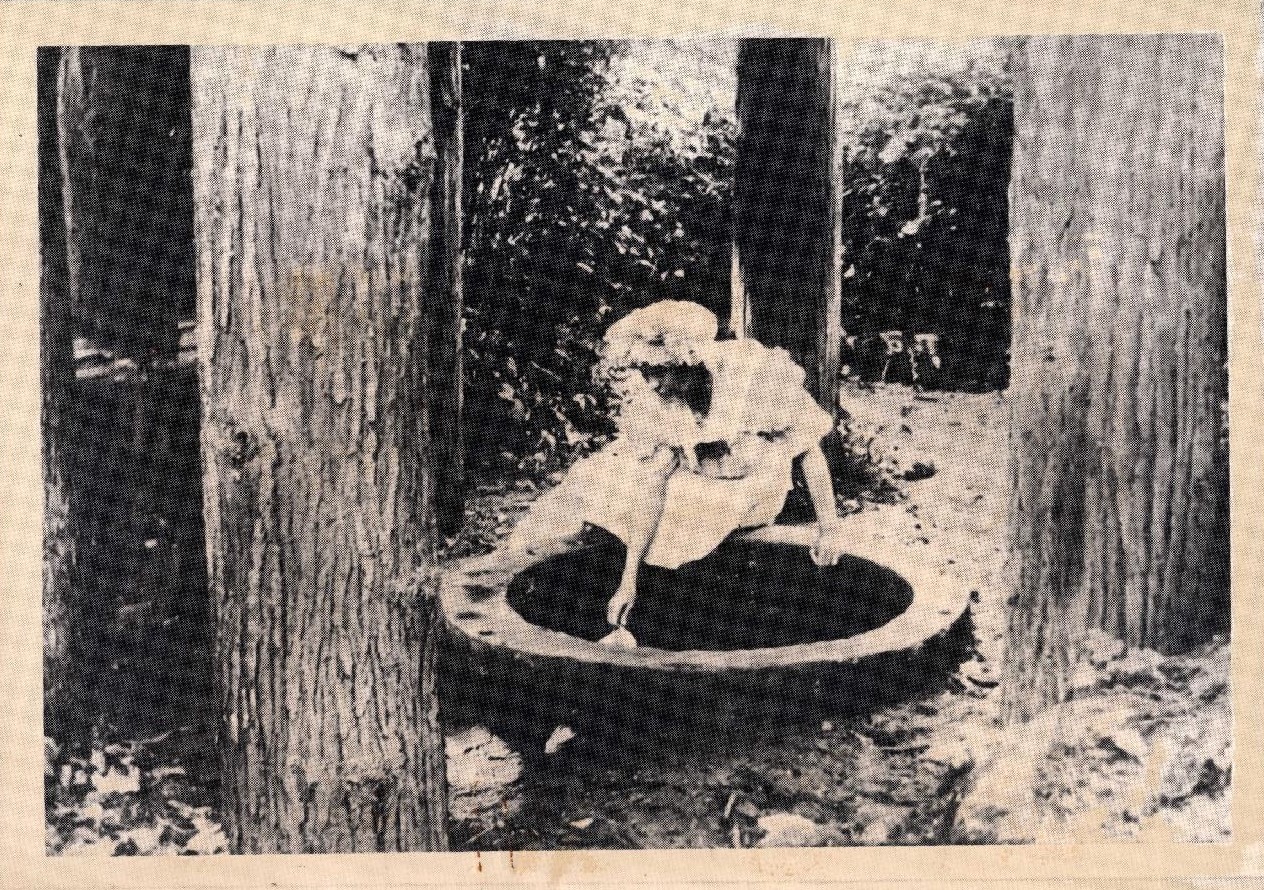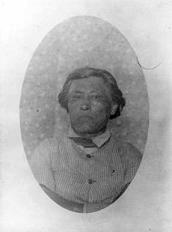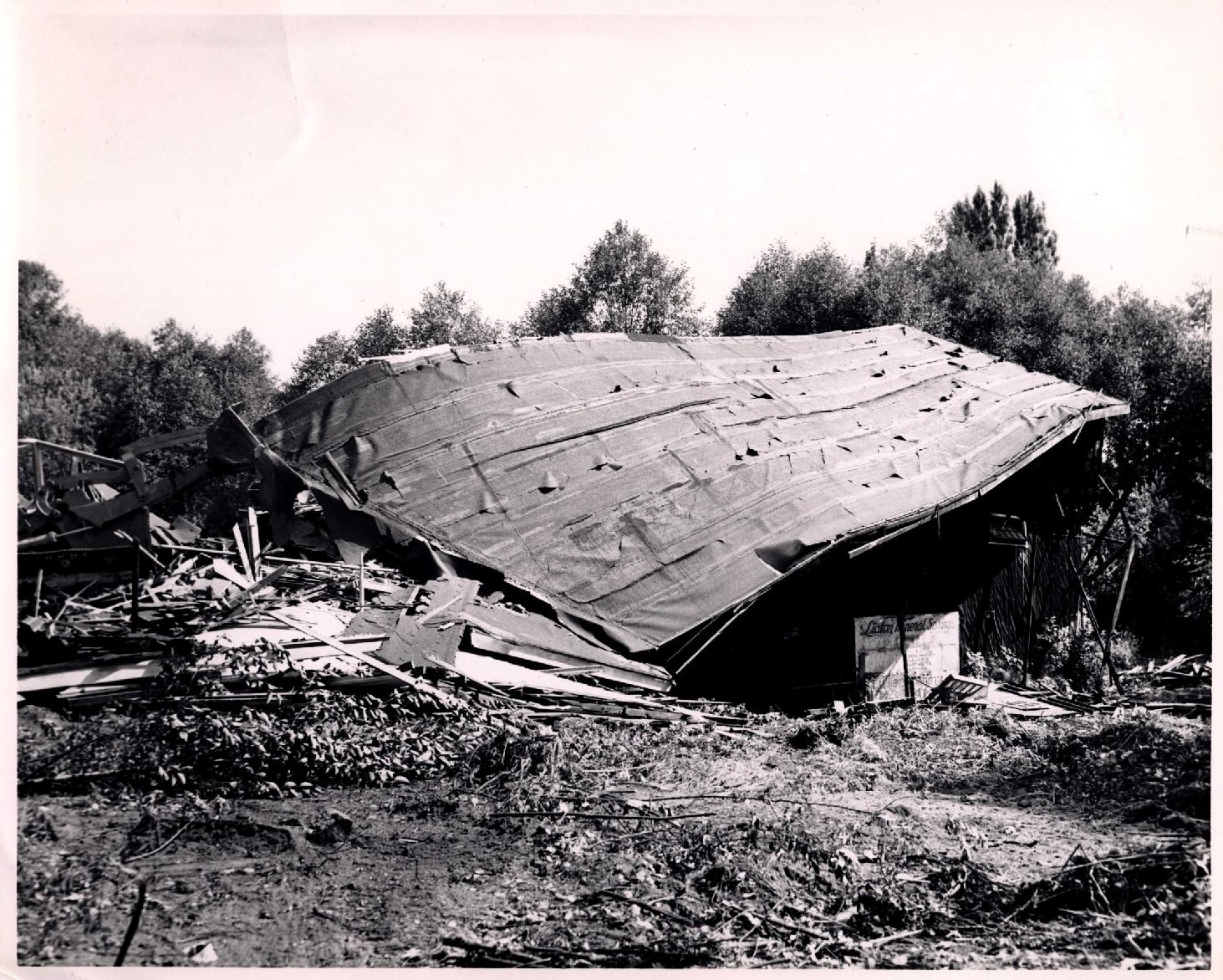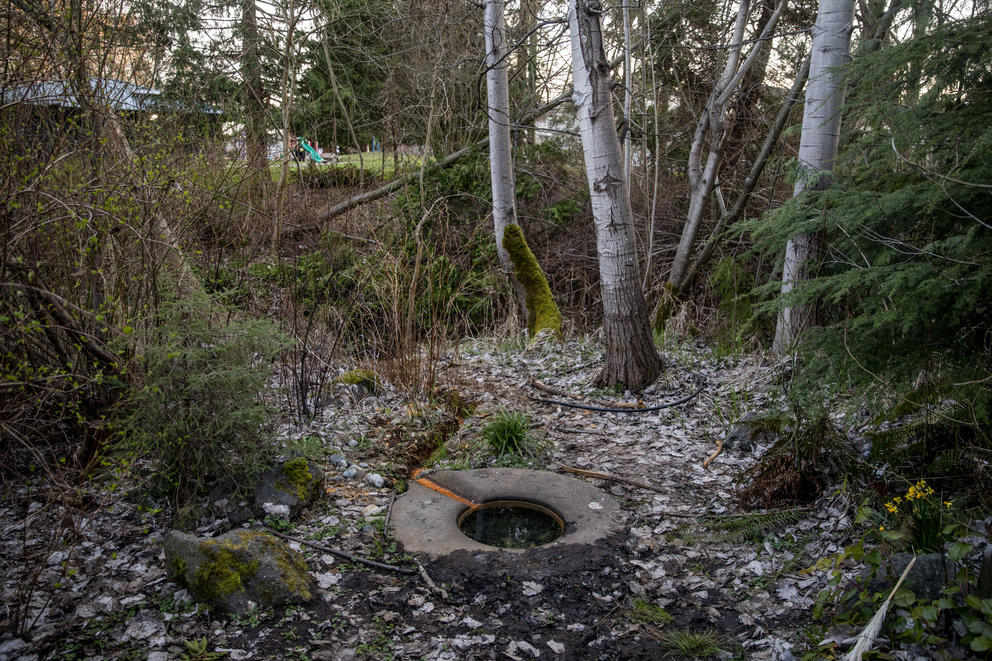A more recent article, from 1990, called it “the North End’s ‘forgotten neighborhood,’” while a blog post from 2017 again calls the creek in one of the neighborhood's parks “hidden, somewhat forgotten.”
To some white non-Natives, this fascination has frequently centered on the neighborhood’s defining mineral spring. But for the Duwamish people and other tribal supporters, the spring of healing water is sacred — and the last of its kind in North Seattle.
Anyone can visit. To find the spring, stop at the playground in Licton Springs Park. North of the slides, a detour into nearby vegetation reveals a slow-moving creek that winds through the park’s tiny grove of trees. Follow the creek to find a spring producing a steady trickle of water with a streambed marked by its reddish iron oxide. Beside it stands a sign that barely acknowledges the spring’s significance to Native people in Seattle and the Duwamish.
Instead, the sign reports that Licton Springs “celebrates its long history as both a unique recreational spot and a commercial crossroads,” adding that the residential neighborhood is named after “Liqtid or Licton, the Salish word for the reddish mud of the springs — one of the few Puget Sound Salish words still used as a place name.”

Seattle-based Lakota activist Matt Remle notes that the only picture on the sign shows a white woman sitting by the spring’s waters. The insufficient signage, Remle says, doesn’t attest to its Native past: “There’s a deep history of ceremonies there."
Once, there were many mineral springs similar to this one in North Seattle. But over the past hundred years the dozens once used by the Duwamish people for spiritual and medicinal purposes have been covered up by pavement and redevelopment.
Remle, Duwamish historian Tom Speer and the Urban Native Education Alliance (UNEA) have worked these past few months to revive the spring’s Native history and work toward designating it as a Seattle historical landmark. Students with UNEA are documenting the spring’s story through film and gathering support with online campaigns, including a petition with over 1,600 signatures in support of making the site a Seattle landmark. This month, they plan to officially apply for landmark status with Seattle’s Landmark Preservation Board. Speer says a hearing to plead their case with the board could take months to schedule.
Rachel Schulkin, communications manager with Seattle Parks and Recreation, says that while a 1996 initiative protects the area from being bulldozed to build apartments or a parking lot, the city still has power to make changes to the area (although there are no open projects for the park).
Seattle Municipal Code also prevents people from taking natural resources, like shrubbery or water, from city-owned parks. In this case, that prohibits Duwamish people from harvesting the red iron oxide from the spring. While citizens can petition the city for exceptions, Schulkin says she is unaware of any exceptions being made for cultural reasons.
Akichita Takenalive, a 16-year-old student who helped author the petition, said he had unwittingly passed the spring thousands of times without knowing its story. Though it lies only a few blocks from UNEA’s meeting site at Robert Eagle Staff middle school, he says he hardly knew it was there. It’s one of the reasons why he thinks the story needs to be told.
“It’s one of the only sacred places that’s been untouched,” he says. “Or, at least, not completely destroyed.”

To call something a landmark in Seattle, the landmark-to-be has to fulfill a couple requirements: It has to be over 25 years old, and must prove historical, cultural, architectural or some other form of significance. Otherwise, a “landmark” can apply to any buildings, sites or objects. For designation to happen, all that’s required is an application that speaks to the proposed landmark’s significance, which is then presented at a public hearing with the Landmarks Preservation Board. If accepted, another public hearing is held to review the designation before an ordinance is brought to the Seattle City Council for a final vote.
Of the more than 400 landmarks already designated by Seattle’s landmarks board since 1973, Seattle Department of Neighborhoods spokesperson Lois Maag says that to her knowledge none are Native cultural sites.
“There are many designated sites or landscapes within the city, but the Native heritage of Licton Springs makes it a unique historic resource,” Maag wrote in an email.
For this reason, the spring could potentially have a case for landmark status on the grounds of cultural significance. Maag added: “Many landmarks have this attribution and may include other designation standards, but the Landmarks Board needs to cite only one.”
The spring, which also goes by the Duwamish name líq’tәd, or “red-paint,” is not the only spring in the area. The “spring” in Mineral Springs Park, only a few blocks from Licton Springs Park, was artificially constructed to commemorate the many springs that once existed in the neighborhood before they were covered or capped. In the 1800s, the area was littered with springs emerging from the 80 acres of marshland that the Duwamish people called “bald head” because of the absence of evergreen trees.
Even though it’s in a city park, the last spring is still at risk if left unprotected, Speer says. The destruction and transformation practices of the past could always return.
This would be an irreplaceable loss for the Duwamish. The red iron oxide of the spring was historically used by the Duwamish for face paint, spiritual practices and as a trading commodity, among other uses. The springs were also medicinal. Speer says the spring’s waters cured the daughter of settler David Denny, Emily Inez, of a skin disease in the late 1800s. White doctors had doubted that Lake Washington Duwamish district chief “Lake John” and Lake Union Duwamish district chief Doctor James Zackuse could succeed where they failed.

As word of its healing properties spread, so did non-Native interest in the springs. Articles from the early 1900s document white people in Seattle visiting to taste the waters and test its healing effects. Articles from the ’30s and ’40s discussed the spring as if it were a new discovery: One clipping from 1942 called it a “natural wonder right in our own front yard,” appealing to the curiosities of white visitors unfamiliar with the history of the site.
For a time, a bathhouse constructed on the Licton Springs site capitalized on the hype, marketing itself as a “healing spa.” An article from the Feb. 14, 1936, edition of the University District Herald said the spa’s existence spread via word of mouth, and added that some people were “coming from other communities outside of Seattle.”
“Why travel to distant resorts when you have a [sic] natural mineral springs located in Seattle?” read an ad for the spa.
Speer says that further development in North Seattle and outside interest made it difficult for the Duwamish to keep up cultural practices like marriage ceremonies — especially as new residents increasingly limited and discouraged access to the area.
“This was a spiritual place,” he says. “But [the Duwamish] were not welcomed.”
The spa and much of the area’s natural vegetation were torn down over the years. The land was bought by the city of Seattle in 1961 after voters approved a park for the site. Licton Springs Park was last renovated in 2016.
White Seattle’s fascination with the spring’s healing properties had died down, and it faded from local memory once more. By then, Speer says, it had been many years since the Duwamish were freely able to use the space, and its cultural history was in peril.

A couple of years ago, Lakota activist Remle starting asking questions about the spring. He had first heard about it from Native friends in the area and brought his daughter, who was part of the UNEA program, to the site.
He later spoke to Duwamish people like Speer about possible protections from redevelopment. Remle isn’t Duwamish himself, but he has a history of fighting for Native historical representation: He helped pass a 2014 resolution to officially create Indigenous People’s Day in Seattle.
“It’s really important, wherever you go, to honor the indigenous people whose lands you’re on,” he says.
When Speer and others said the spring had no formal protection, Remle and Speer began a mission to change that. Their attempts to landmark the spring in 2016 were unsuccessful: It was their first time navigating the process, so Remle and Speer shelved the project to take stock and collect the information needed to try again. They also wanted the next iteration of the project to include Native youth in the process, which led to a partnership with UNEA.
“We want to be engaging young Native people in this political process, getting them information about local Duwamish sacred sites and what they are and why to protect them,” Remle says.
Others organizations joined in. Design firm Mithun, community volunteers and the Seattle Public Library helped research the spring’s cultural significance ahead of another landmark status application. The library aided Native students by training them in social media skills, helping them launch social media campaigns to bring awareness and signatures to the effort.
UNEA Chair Sarah Sense-Wilson says the experience has helped Native youth in her program learn about the spring and understand why preserving sites like this one and their histories is important. The students meet weekly at the Robert Eagle Staff School, where some of them attend school.
“I’d seen the site before, but [this time] I got to see it close up and learn more about it,” says JoAnne Sayers Pinkham, a 14-year-old student with the program.
Sense-Wilson hopes UNEA students can testify at the landmark hearing for the spring if they get one in the coming months: “[It’s] an opportunity for youth to stand up and relate what they’ve learned.”
It’s difficult to find documentation of the spring’s Native history in Seattle Public Library records; much of the knowledge is passed down through the generations by elders like Speer. Materials on Licton Springs from the Seattle Public Library’s Special Collections mostly consist of newspaper clips, books and photographs — often produced by white storytellers without any Native consultation.
If landmark status is granted, Native storytellers can begin reclaiming the spring’s story, Remle hopes. For Native groups behind the effort, the work being done to landmark the spring isn’t an act of “rediscovery” — it’s an act of reclamation.
Speer hopes the revitalization movement could lead city officials to update the signage at the park’s spring to reflect its Duwamish history. He first heard about the spring in the ’60s from Joe Hillaire, a Lummi artist known for carving totem poles. He told Speer about the spring’s red iron oxide, and the traditional process used to turn it into paint for poles.
“For most [projects] that were commercial poles, he would use commercial paint, but he knew what we used to do [at the spring] and commented on it,” Speer says. “That’s how I learned it.”
Speer learned Native histories by listening to the stories of Hillaire and his other elders, remembering them for future generations. He says that the UNEA students fighting for the spring’s preservation are engaging in the same tradition.
“Guys like me … aren’t going to be here forever,” he says. Now, he says it’s up to people like the students to pass down this story again.



